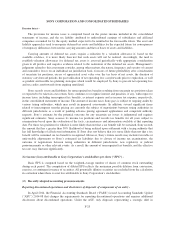Sony 2015 Annual Report Download - page 157
Download and view the complete annual report
Please find page 157 of the 2015 Sony annual report below. You can navigate through the pages in the report by either clicking on the pages listed below, or by using the keyword search tool below to find specific information within the annual report.SONY CORPORATION AND CONSOLIDATED SUBSIDIARIES
Revenue arrangements with customers may include multiple elements, including any combination of
products, services and software. An example includes sales of electronics products with rights to receive
promotional goods. For Sony’s multiple element arrangements where at least one of the elements is not subject to
existing software or film revenue recognition guidance, elements are separated into more than one unit of
accounting when the delivered element(s) have value to the customer on a standalone basis, and delivery of the
undelivered element(s) is probable and substantially in the control of Sony. Revenue is then allocated to each unit
of accounting based on the relative selling price of each unit of accounting based first on vendor-specific
objective evidence of selling price (“VSOE”) if it exists, based next on third-party evidence of selling price
(“TPE”) if VSOE does not exist, and, finally, if both VSOE and TPE do not exist, based on estimated selling
prices (“ESP”). VSOE is limited to either the price charged for an element when it is sold separately or, for an
element not yet being sold separately, the price established by management having the relevant authority; it must
be probable that the price, once established, will not change before the separate introduction of the element into
the market place. TPE is the price of Sony’s or any competitor’s largely interchangeable products or services in
standalone sales to similarly situated customers. ESP is the price at which Sony would transact if the element
were sold by Sony regularly on a standalone basis. When determining ESP, Sony considers all relevant inputs,
including sales, cost and margin analysis of the product, targeted rate of return of the product, competitors’ and
Sony’s pricing practices and customer perspectives.
Certain software products published by Sony provide limited on-line features at no additional cost to the
customer. Generally, such features are considered to be incidental to the overall software product and an
inconsequential deliverable. Accordingly, revenue related to software products containing these limited on-line
features is not deferred.
Revenues from sales in the Pictures segment are recognized when persuasive evidence of an arrangement
exists, the sales price is fixed or determinable and collectability is reasonably assured. Revenues from the
theatrical exhibition of motion pictures are recognized as the customer exhibits the film. Revenues from the
licensing of motion picture and television product for pay and free television exhibition and other markets are
recognized when the product is available for exploitation by the licensee and when any restrictions regarding the
use of the product lapse. For home entertainment distribution, revenues from the sale of DVDs and Blu-ray
Disc™, net of anticipated returns and sales incentives, are recognized when the product is available for sale to the
public, and revenues from electronic sell-through and video-on-demand are recognized when the product is made
available for viewing via digital distribution platforms. Certain motion picture and television product licensing
arrangements involve an allocation to multiple elements, for example a fee for multiple territories and
availability dates, that is based on relative fair value using management’s best estimate. Revenues from the sale
of broadcast advertising are recognized when the advertisement is aired. Revenues from subscription fees
received by television networks are recognized when the service is provided.
Traditional life insurance policies that the life insurance subsidiary underwrites, most of which are
categorized as long-duration contracts, mainly consist of whole life, term life and accident and health insurance
contracts. Premiums from these policies are reported as revenue when due from policyholders.
Amounts received as payment for non-traditional contracts such as interest sensitive whole life contracts,
individual annuity contracts and other contracts without life contingencies are recognized in policyholders’
account in the life insurance business. Revenues from these contracts are comprised of fees earned for
administrative and contract-holder services, which are recognized over the period of the contracts, and included
in financial services revenue.
Property and casualty insurance policies that the non-life insurance subsidiary underwrites are primarily
automotive insurance contracts which are categorized as short-duration contracts. Premiums from these policies
are reported as revenue over the period of the contract in proportion to the amount of insurance protection
provided.
F-23
























